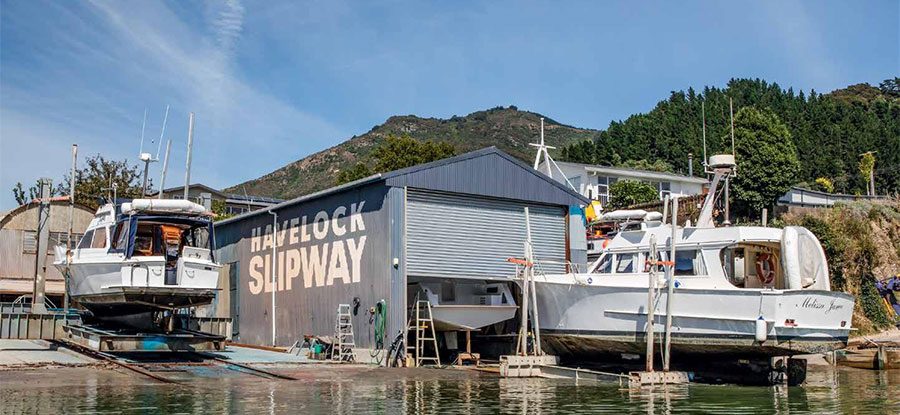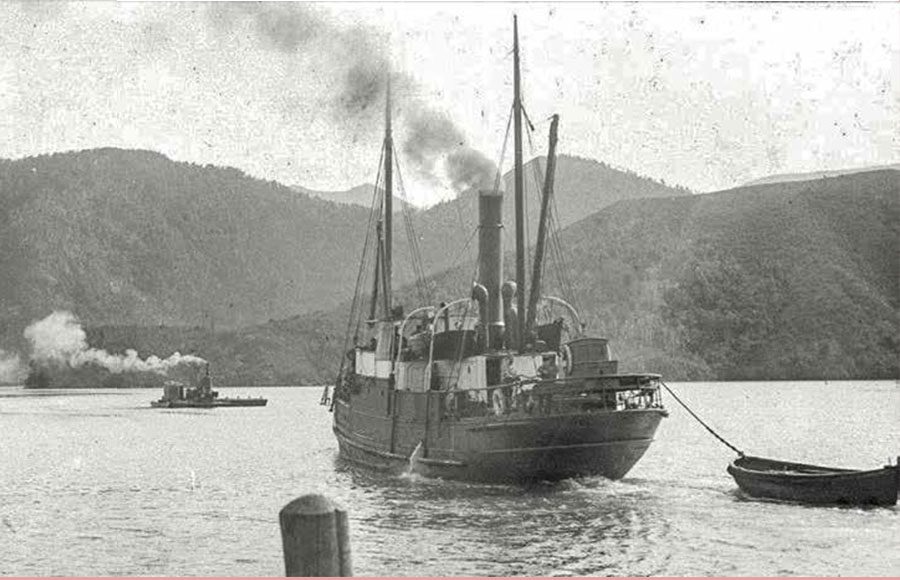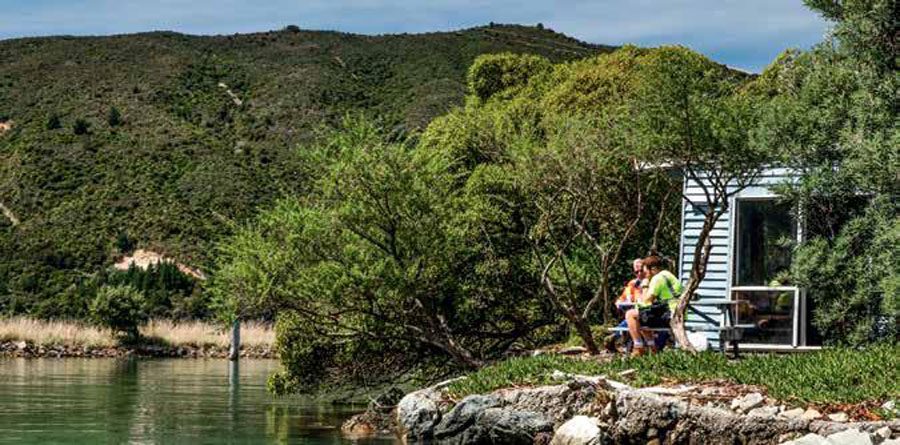

Lesley and I sneak up the Pelorus River delta in our wee rubber dinghy powered by a purringly-quiet Honda four-stroke 4hp outboard.
This is much to the dismay – and hilarity – of the locals, who mostly belong to the Te Hoiere Seagull Fleet, and who organise races up and back on the same route.
The rules of their event: any boat will do – the more eccentric the better (including a pirate ship made from re-purposed mussel buoys) – but it must be pushed by a British Seagull outboard motor. The races, held every two months and preceded by a ‘skite-yer-boat’ parade down the main street of Havelock, are hotly (and noisily) contested. Although not officially part of the rules, the Te Hoiere Seagull Fleet race boats also all sport bright, home-made flags. And, mostly, ingenious steering and refuelling systems.
One ambition amongst the racers is to be busted by the Havelock port captain for exceeding eight knots in the channel. Hasn’t happened yet.


We chose the quieter option. Which was rewarding all the same. The Pelorus River, above the tidal influence, is renowned for crystal-clear water, and fish aplenty. Which we got, muchly. And other surprises.
But first, we got lost. Graham Smith, the doyen of the Seagull Fleet (he has – get this – more than 150 Seagull outboards in his shed) gave us a map of the racecourse. The Pelorus River spreads into a delta even before it reaches the tide, offering a loop up and down. To get to the route used for upstream entails either going down the main marina entry channel a wee ways at high or incoming tide, or else cutting left across Kaikumera Bay and what could be mudflats, to find the entry to the river through banks of sedge grasses. But we got a bit confused. And besides, Lesley had pictures to take of wildlife (including a huge swimming spider), and the unique Kiwi vernacular architecture of maimais.
By which time the tide had turned, so we came back another day. At least we knew where to go this time.


This Up the Creek adventure specialises in intriguing history. One of the first diversions on the way up is an inlet on the north side where a timber mill once was. Then, back to the main part of the channel, where birds of many species announce our passing. Two blokes working with a digger in a paddock do the South Island sideways nod to acknowledge us. But it’s clear our outboard is not up to muster. We putter past quietly, a bit embarrassed.
Then under a high bridge, which carries the road to Kaiuma Bay Road and the north-west side of Pelorus Sound.
And up on the right, an old homestead and boat yard, where some quite big boats have been built.
By now we’re out of the tidal water, and the famously crystal-clear water of the Pelorus River is buoying us up. It’s a special sensation, this being supported by something almost invisible. We can see the rocks and roots clearly on the bottom, many metres down.
Graham’s map of the racecourse guides us to the epitome of this. In a side channel, a tunnel of green entirely covered by a canopy of willows, and – if this is possible – even clearer water below.


Not much further above this is where the single stream of Te Hoiere, the Pelorus River, splits into the two main channels of its delta. There’s quite a wide turning circle here in a calm basin fringed with beaches. Looking upstream, past a riffle of small rapids, we can see the river continuing in a curve to the right. I would have liked to follow this further another mile or so to the confluence with the Wakamarina River at Canvastown, and a tie-up spot just below the Pelorus Tavern and its Trout Bar. But it’s a bridge too far. By way of compensation, a giant trout leaps out of the water just in front of our dinghy.
The other appeal of Canvastown is the collection of murals in the Canvastown Hall, by the under-appreciated Kiwi legend, folk-art painter Ōriwa Haddon. At the end of a rich and full life as kapa haka performer, chemist, soldier and broadcaster, Haddon, his wife and eleven kids(!) got to go wandering about as an itinerant artist, paying his way by leaving paintings in lieu of paying accommodation bills. Upstairs in the corridors and rooms of the Havelock Pub is also another gallery of his work.
We set off downstream down the right-hand arm, back towards the river mouth and Havelock. Giant kahikatea, matai, rimu and tōtara logs lie waterlogged on the bottom of the river. Whether they are remnants of natural attrition, or lost stock from historic logging operations, we cannot tell. A tramway was built in the 1880s to transport logs down to the mills. But before that, they were floated down the river. Either way, they must be still a valuable resource. This valley has a rich history of extensive logging and timber-milling operations, and for a short time mining too, which hit payable gold at Wakamarina in 1863. But by 1865, the miners had moved on to other gold rushes. Canvastown never had the chance to become more permanent.


To the left is rich, level, river-loam farmland in the island created by the arms of the river. To the right is Graham’s riverside spread, his garden another folk-art gallery of his sculptures fashioned from re-purposed mussel-buoys.
The river here is wide, deep and sleepy. We find secret places, where old boats lie in quiet moorings in small inlets, tied up to the trees. State Highway 6, the road from Havelock to Nelson, follows the river here, hugging its south side bank.
After a broad sweep to the right, there’s a reed-fringed inlet, where the huge and bustling Blackball Sawmill was established in the 1870s. It was the noisy, beating heart of a busy little town, with houses clambering up the steep hillsides. There are still rusty old corrugated-iron buildings there. And the hulk of the ship Pelorus. Also, the sheds for a boat-building operation on the edge of the water. Even still existing, a dovecote on top of the shed, where carrier pigeons were kept by the mill company – their river traffic comms system. And again, now, some quiet moorings.
The Blackball Mill was one of three owned by Brownlee & Co in these parts. Its empire also included 45km of tramline, four locos, and a fleet of four coastal trading ships: Clematis, Falcon, Ronga and Eunice. They had a setback in 1904 when a flood carried away all the main bridges over the Wakamarina, Pelorus and Rai Rivers. “It took all hands nearly a year to effect repairs, with all shipping stopped,” says the Havelock Museum’s page on Brownlee Milling.


But by 1915, the native timber was gone. Brownlee & Co shut up shop and moved to the West Coast.
Linden Armstrong, a Havelock historian, has the pithy summation: “Once the wood was gone, so was the town.”
Blackball got its name from a country store that preceded the mill on that site, which flew a flag with a black ball on it. In a nod to the symmetry of history, the current owner of the property, Pamela Hayter, raises black-faced sheep there now.
The logging ships had to come up to Blackball because they couldn’t extend the logging tramline downstream beyond a steep bluff called Cape Horn. We rounded it safely.
The 1906 Encyclopaedia of New Zealand summed up this history. “While the diggings were in full swing, and the timber industry was busy at the same time, trade flourished at the port: yet though the mines gave way, and sawmilling fell off, the town experienced no violent depression, owing to the steady growth of the farming industry, which is now its chief support.”

Add to that farming in the water. Mussels. Like so many New Zealand small towns, Havelock needs something big, so it proclaims itself ‘the mussel capital of the world.’ And indeed, the mussel barges own the channel to the harbour, the mussel factories hum day and night puffing out random white smoke signals, heavy mussel trucks wheelspin and churn up the smooth new tarmac just laid in the main drag. And the entire town is littered with larger-than-life fibreglass mussels, which eyeball you with cartoon eyes from rooftops and the marina mole, and at knee-height from the curb. It’s all a bit weird – but in the nicest possible way.
Lesley and I make our languid way back to Havelock central and Skyborne in the marina there. On our way we share unhurried yarns with a retired couple fishing, a bloke shoring up his seawall and the fullas having smoko at the mussel factory. The view from their picnic table is among the best in the world.
We’re left with lovely Up the Creek memories of the tidal delta of Te Hoiere, the crystal-clear waters of the Pelorus River, the historic sites along the waterways – and the abiding impression that, although it’s the mussel capital of the world, it almost seems against the law to be in a hurry in these parts. Except of course in the Seagull races. And all that’s a good thing. BNZ




